The Strengthening and Toughening of Biodegradable Poly (Lactic Acid) Using the SiO2-PBA Core–Shell Nanoparticle
Abstract
1. Introduction
2. Materials and Methods
2.1. Materials
2.2. Synthesis of Core–Shell Nanoparticles
2.3. Preparation of PLA-Based Nanocomposite
2.4. Characterization of Nanoparticle and Composites
3. Finite Element Modelling
3.1. Representive Volume Element (RVE)
3.2. Periodic Boundary Conditions
4. Experimental Results and Discussion
4.1. Thermal Properties
4.2. Mechanical Properties of Nanocomposites
4.3. Toughening Mechanisms of Nanoparticles
5. Numerical Analysis and Comparison with Experimental Results
5.1. Mechanical Behavior and Damage Process of PLA/SiO2 Composite
5.2. Mechanical Behavior and Damage Process of PLA/SiO2-PBA-NH2 Composite
6. Conclusions
- (1)
- The experimental results showed that the incorporation of core–shell nanofiller is an excellent strategy to simultaneously improve the strength and toughness of biodegradable poly (lactic acid), as the tensile, flexural properties and impact resistance of PLA were improved; in particular, the tensile toughness and elongation at break of PLA were enhanced. Furthermore, the proposed micromechanical model can be used to illustrate the experimental behaviors of particle-reinforced composites.
- (2)
- From the experimental observation combined with the numerical analysis, it was shown that for the rigid particle reinforced composite, the interfacial debonding and subsequent matrix cracking predominantly occur during the tension. Notably, as the flexible polymer layer was covered on the rigid particle, the failure process of the composite transforms to the cavitation of the polymer shell and induces matrix shear yielding, which plays a vital role in the toughening of the polymer.
Supplementary Materials
Author Contributions
Funding
Acknowledgments
Conflicts of Interest
References
- Kakroodi, A.R.; Kazemi, Y.; Ding, W.; Ameli, A.; Park, C.B. Poly (lactic acid)-based in situ microfibrillar composites with enhanced crystallization kinetics, mechanical properties, rheological behavior, and foaming ability. Biomacromolecules 2015, 16, 3925–3935. [Google Scholar] [CrossRef]
- Nofar, M.; Park, C.B. Poly (lactic acid) foaming. Prog. Polym. Sci. 2014, 39, 1721–1741. [Google Scholar] [CrossRef]
- Gross, R.A.; Kalra, B. Biodegradable polymers for the environment. Science 2002, 297, 803–807. [Google Scholar] [CrossRef]
- Nampoothiri, K.M.; Nair, N.R.; John, R.P. An overview of the recent developments in polylactide (PLA) research. Bioresour. Technol. 2010, 101, 8493–8501. [Google Scholar] [CrossRef]
- Joziasse, C.A.; Veenstra, H.; Grijpma, D.W.; Pennings, A.J. On the chain stiffness of poly (lactide) s. Macromol. Chem. Phys. 1996, 197, 2219–2229. [Google Scholar] [CrossRef]
- Zhang, C.; Wang, W.; Huang, Y.; Pan, Y.; Jiang, L.; Dan, Y.; Peng, Z. Thermal, mechanical and rheological properties of polylactide toughened by expoxidized natural rubber. Mater. Des. 2013, 45, 198–205. [Google Scholar] [CrossRef]
- Bitinis, N.; Verdejo, R.; Cassagnau, P.; Lopez-Manchado, M.A. Structure and properties of polylactide/natural rubber blends. Mater. Chem. Phys. 2011, 12, 823–831. [Google Scholar] [CrossRef]
- Jiang, L.; Zhang, J.; Wolcott, M.P. Comparison of polylactide/nano-sized calcium carbonate and polylactide/montmorillonite composites: Reinforcing effects and toughening mechanisms. Polymer 2007, 48, 7632–7644. [Google Scholar] [CrossRef]
- Petchwattana, N.; Covavisaruch, S.; Petthai, S. Influence of talc particle size and content on crystallization behavior, mechanical properties and morphology of poly (lactic acid). Polym. Bull. 2014, 71, 1947–1959. [Google Scholar] [CrossRef]
- Fukushima, K.; Tabuani, D.; Arena, M.; Gennari, M.; Camino, G. Effect of clay type and loading on thermal, mechanical properties and biodegradation of poly (lactic acid) nanocomposites. React. Funct. Polym. 2013, 73, 540–549. [Google Scholar] [CrossRef]
- Thitsartarn, W.; Fan, X.; Sun, Y.; Yeo, J.C.C.; Yuan, D.; He, C. Simultaneous enhancement of strength and toughness of epoxy using POSS-Rubber core–shell nanoparticles. Compos. Sci. Technol. 2015, 118, 63–71. [Google Scholar] [CrossRef]
- Liu, S.; Fan, X.; He, C. Improving the fracture toughness of epoxy with nanosilica-rubber core-shell nanoparticles. Compos. Sci. Technol. 2016, 125, 132–140. [Google Scholar] [CrossRef]
- Williams, J.J.; Segurado, J.; LLorca, J.; Chawla, N. Three dimensional (3D) microstructure-based modeling of interfacial decohesion in particle reinforced metal matrix composites. Mater. Sci. Eng. A 2012, 557, 113–118. [Google Scholar] [CrossRef]
- Meng, Q.; Wang, Z. Prediction of interfacial strength and failure mechanisms in particle-reinforced metal-matrix composites based on a micromechanical model. Eng. Fract. Mech. 2015, 142, 170–183. [Google Scholar] [CrossRef]
- Cho, J.; Joshi, M.S.; Sun, C.T. Effect of inclusion size on mechanical properties of polymeric composites with micro and nano particles. Compos. Sci. Technol. 2006, 66, 1941–1952. [Google Scholar] [CrossRef]
- Tsui, C.P.; Tang, C.Y.; Fan, J.P.; Xie, X.L. Prediction for initiation of debonding damage and tensile stress–strain relation of glass-bead-filled modified polyphenylene oxide. Int. J. Mech. Sci. 2004, 46, 1659–1674. [Google Scholar] [CrossRef]
- Li, S.; McCarthy, S. Influence of crystallinity and stereochemistry on the enzymatic degradation of poly (lactide) s. Macromolecules 1999, 32, 4454–4456. [Google Scholar] [CrossRef]
- Goudarzi, T.; Spring, D.W.; Paulino, G.H.; Lopez-Pamies, O. Filled elastomers: A theory of filler reinforcement based on hydrodynamic and interphasial effects. J. Mech. Phys. Solids 2015, 80, 37–67. [Google Scholar] [CrossRef]
- Ke, Z.; Shi, D.; Yin, J.; Li, R.K.; Mai, Y.W. Facile method of preparing supertough polyamide 6 with low rubber content. Macromolecules 2008, 41, 7264–7267. [Google Scholar] [CrossRef]
- LLorca, J.; Segurado, J. Three-dimensional multiparticle cell simulations of deformation and damage in sphere-reinforced composites. Mater. Sci. Eng. A 2004, 365, 267–274. [Google Scholar] [CrossRef]
- Nofar, M.; Tabatabaei, A.; Park, C.B. Effects of nano-/micro-sized additives on the crystallization behaviors of PLA and PLA/CO2 mixtures. Polymer 2013, 54, 2382–2391. [Google Scholar] [CrossRef]
- Domun, N.; Hadavinia, H.; Zhang, T.; Sainsbury, T.; Liaghat, G.H.; Vahid, S. Improving the fracture toughness and the strength of epoxy using nanomaterials–a review of the current status. Nanoscale 2015, 7, 10294–10329. [Google Scholar] [CrossRef]
- Yang, H.; Li, F.; Shan, C.; Han, D.; Zhang, Q.; Niu, L.; Ivaska, A. Covalent functionalization of chemically converted graphene sheets via silane and its reinforcement. J. Mater. Chem. 2009, 19, 4632–4638. [Google Scholar] [CrossRef]
- Li, X.; Lei, B.; Lin, Z.; Huang, L.; Tan, S.; Cai, X. The utilization of bamboo charcoal enhances wood plastic composites with excellent mechanical and thermal properties. Mater. Des. 2014, 53, 419–424. [Google Scholar] [CrossRef]
- Herrera, N.; Mathew, A.P.; Oksman, K. Plasticized polylactic acid/cellulose nanocomposites prepared using melt-extrusion and liquid feeding: Mechanical, thermal and optical properties. Compos. Sci. Technol. 2015, 106, 149–155. [Google Scholar] [CrossRef]
- Choi, K.M.; Choi, M.C.; Han, D.H.; Park, T.S.; Ha, C.S. Plasticization of poly (lactic acid)(PLA) through chemical grafting of poly (ethylene glycol)(PEG) via in situ reactive blending. Eur. Polym. J. 2013, 49, 2356–2364. [Google Scholar] [CrossRef]
- Dompas, D.; Groeninckx, G. Toughening behaviour of rubber-modified thermoplastic polymers involving very small rubber particles: 1. A criterion for internal rubber cavitation. Polymer 1994, 35, 4743–4749. [Google Scholar] [CrossRef]
- Matouš, K.; Geubelle, P.H. Multiscale modelling of particle debonding in reinforced elastomers subjected to finite deformations. Int. J. Numer. Methods Eng. 2006, 65, 190–223. [Google Scholar] [CrossRef]
- Tsui, C.P.; Chen, D.Z.; Tang, C.Y.; Uskokovic, P.S.; Fan, J.P.; Xie, X.L. Prediction for debonding damage process and effective elastic properties of glass-bead-filled modified polyphenylene oxide. Compos. Sci. Technol. 2006, 66, 1521–1531. [Google Scholar] [CrossRef]
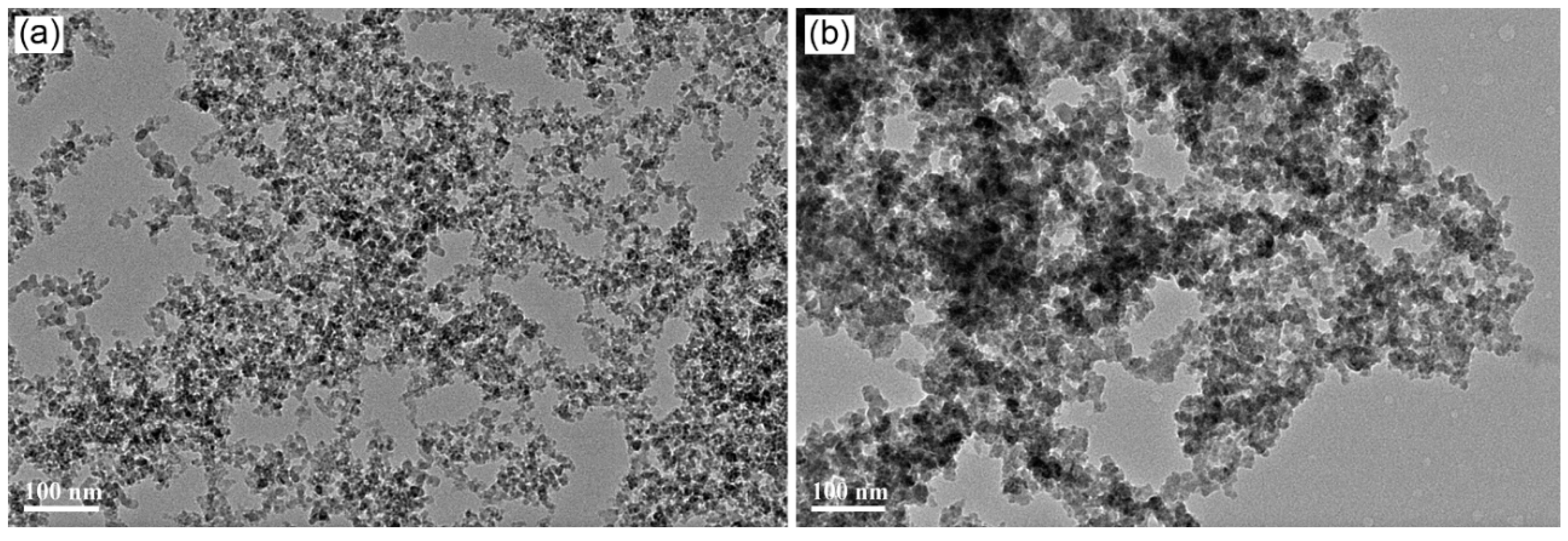
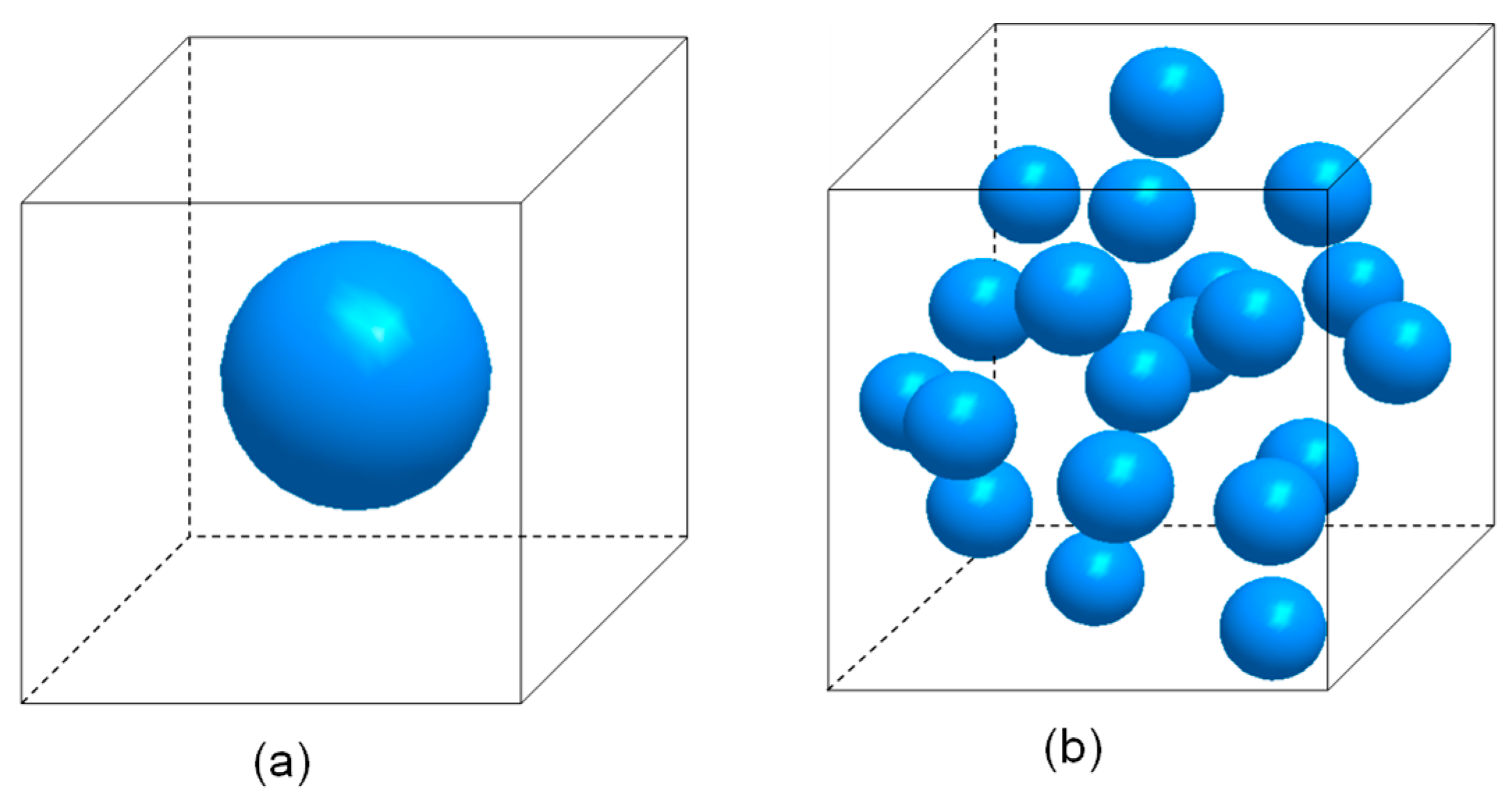
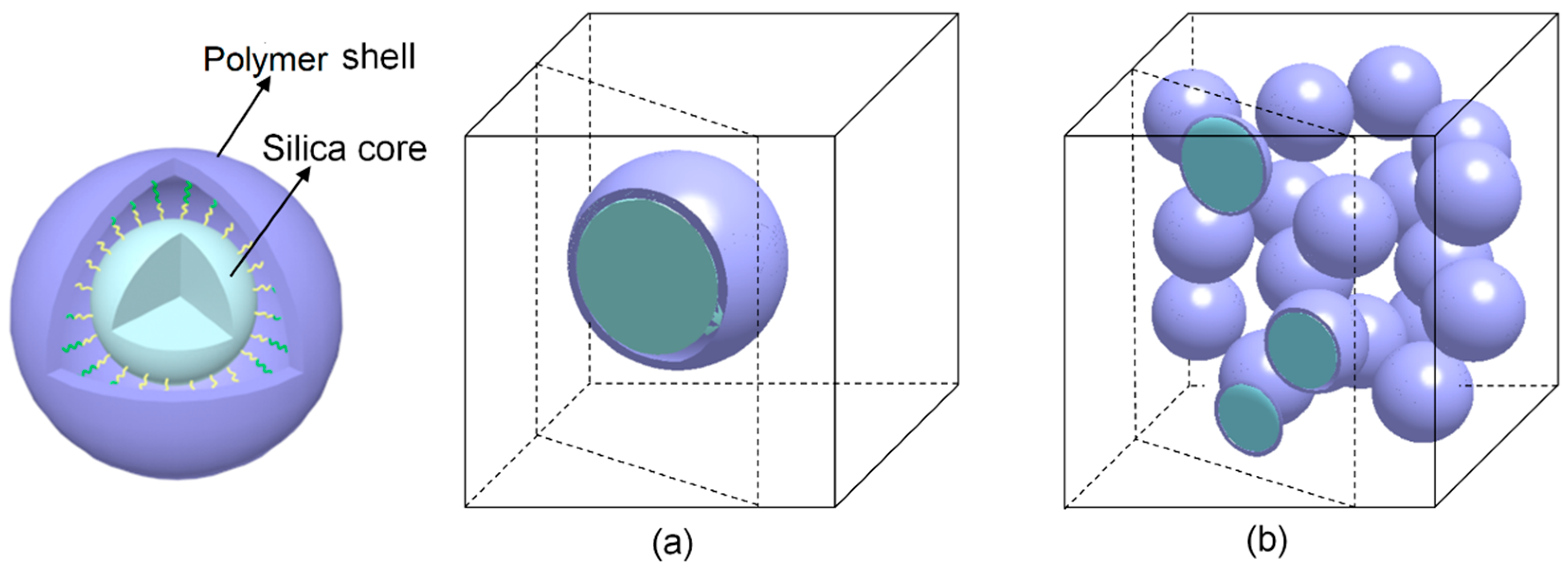

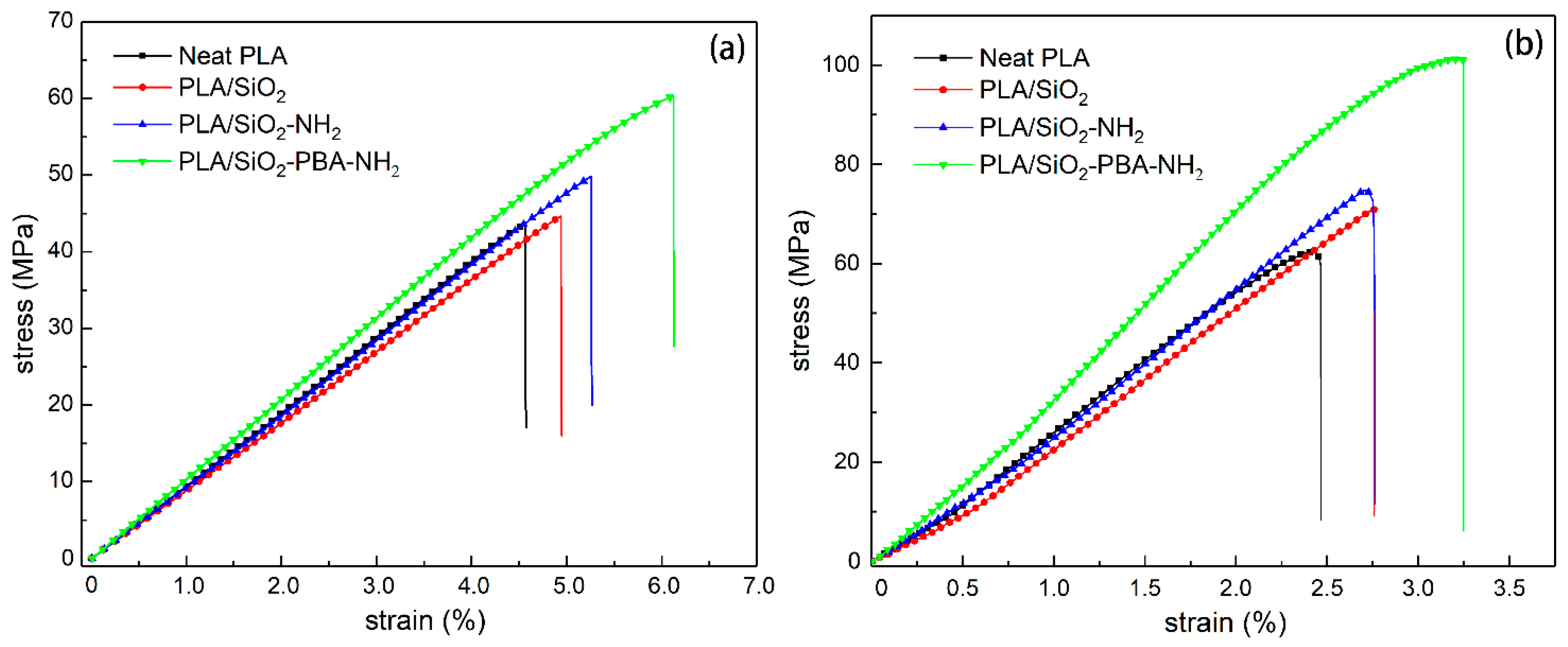
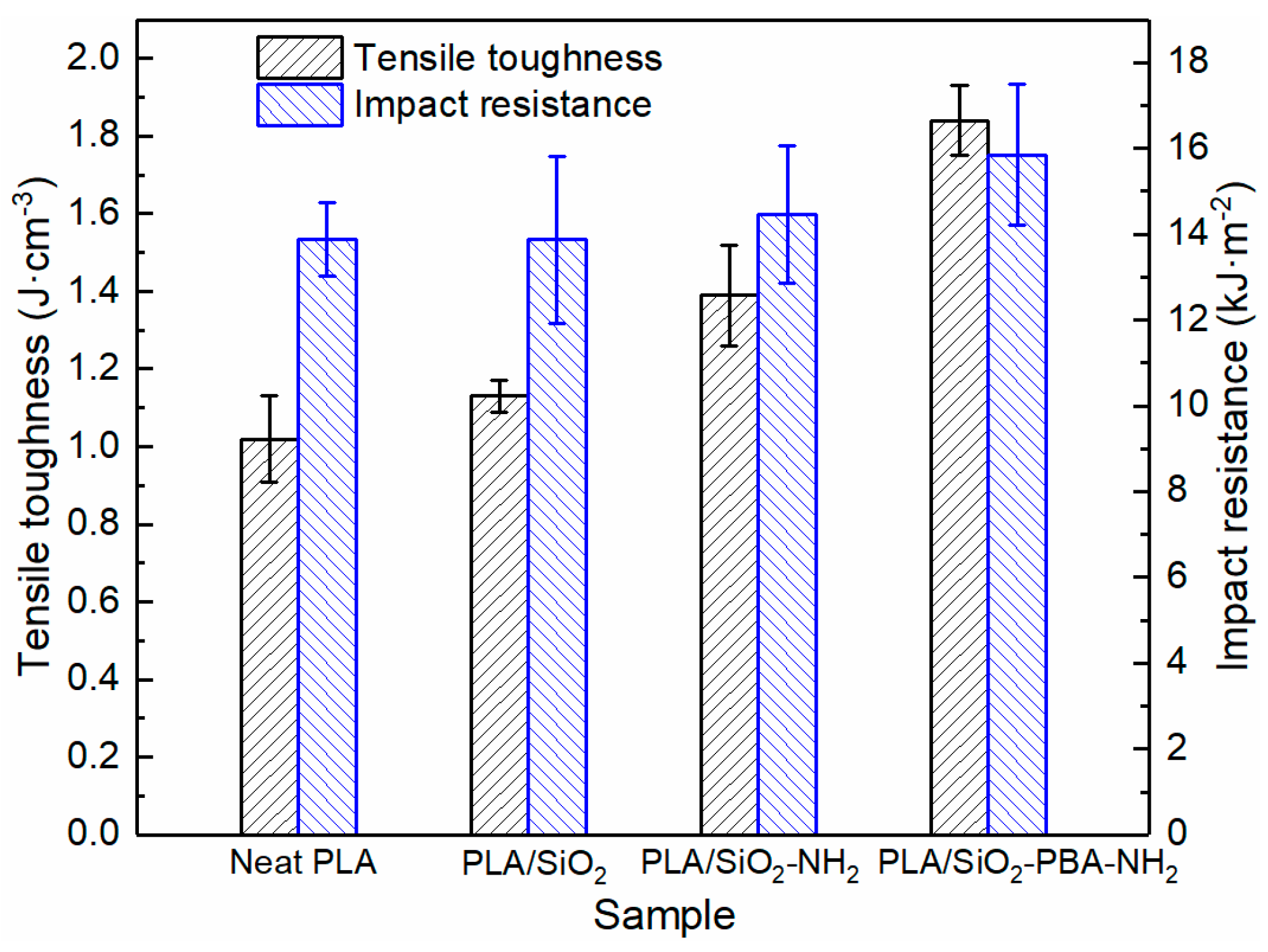



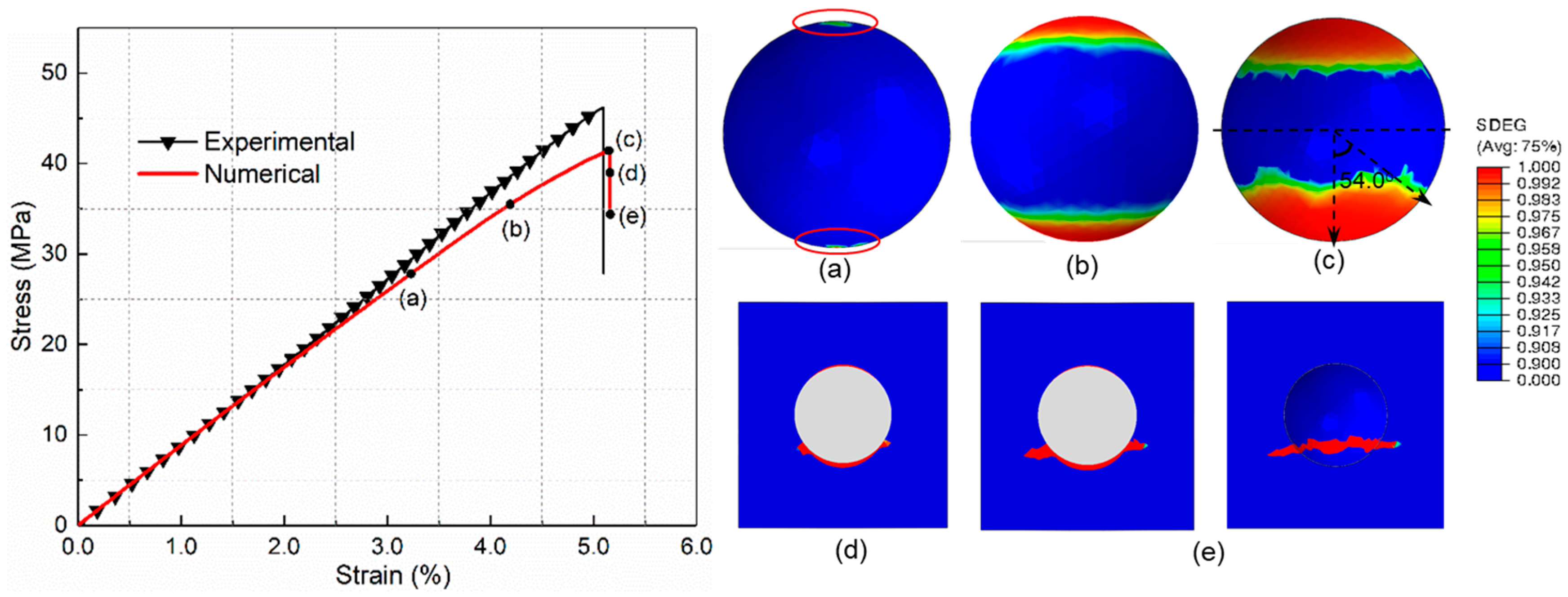
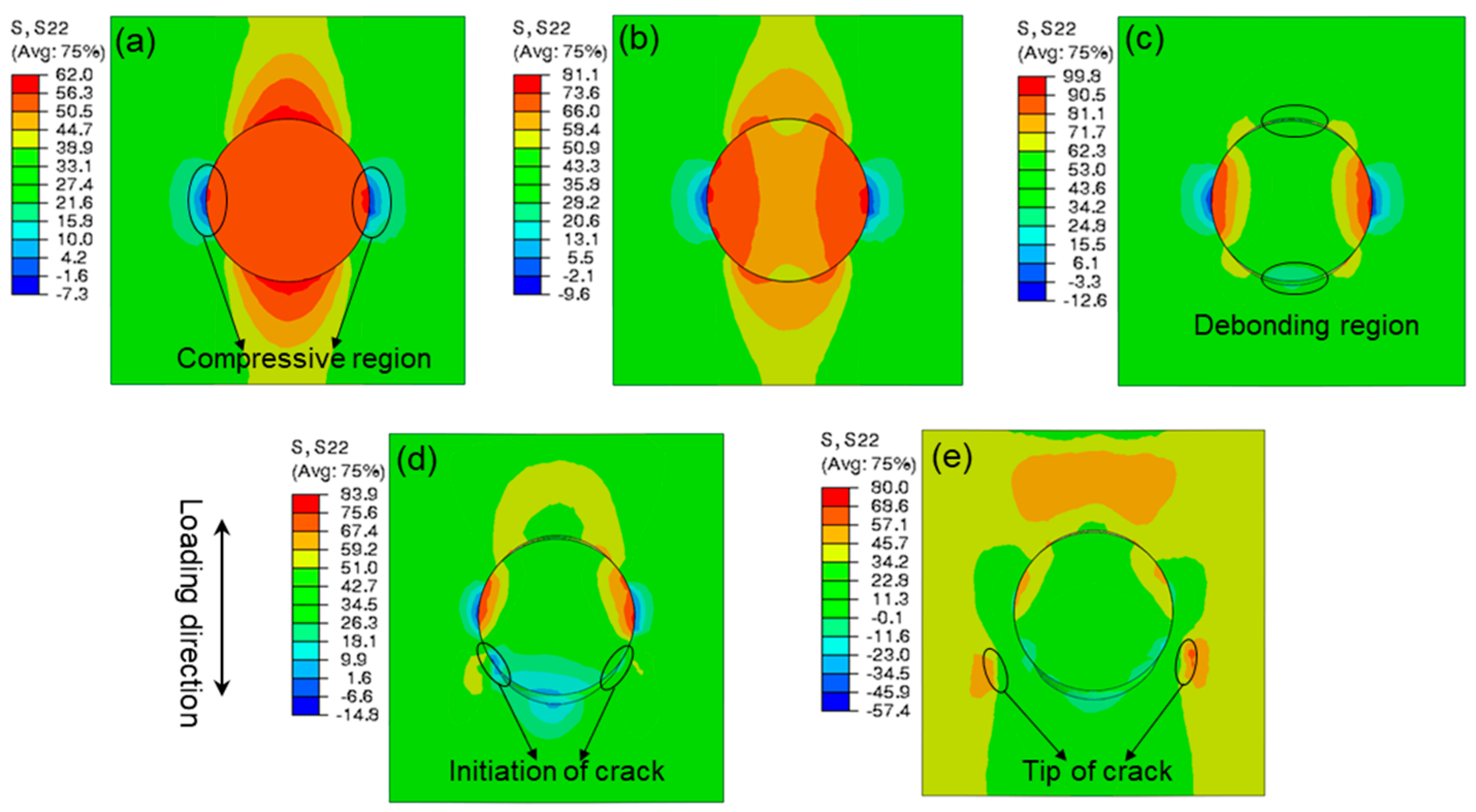
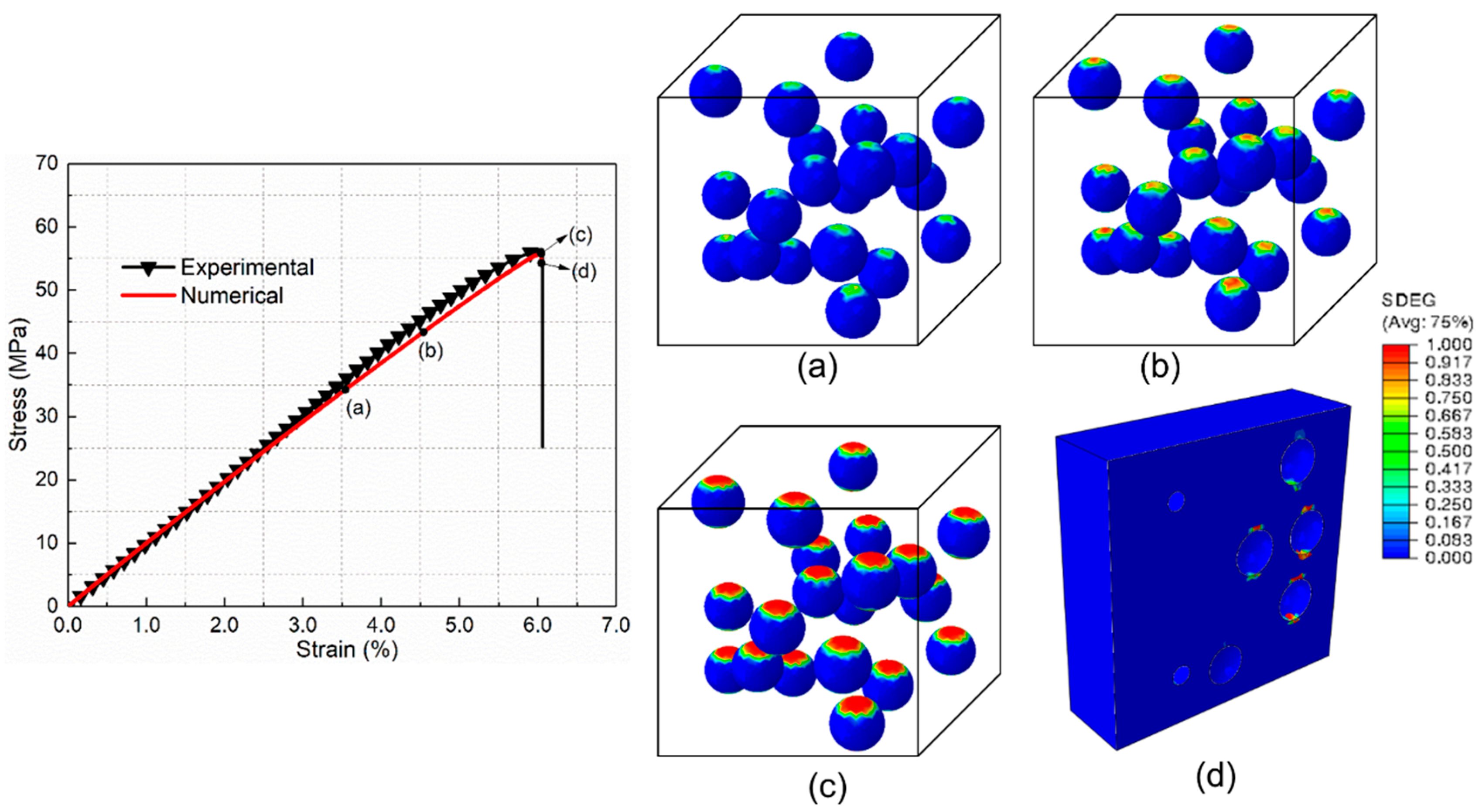
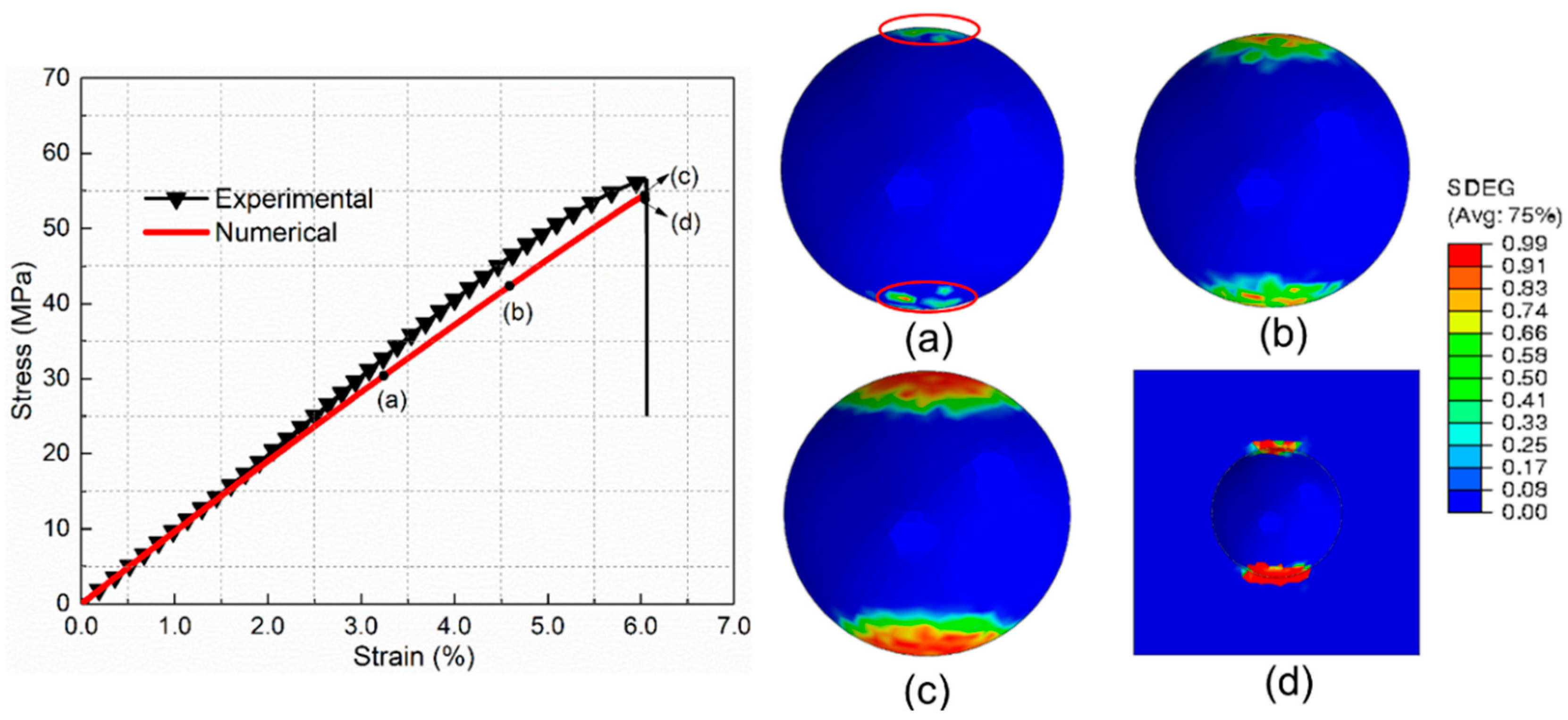

| Sample | Tensile Properties | Flexural Properties | Impact Resistance | ||||
|---|---|---|---|---|---|---|---|
| Tensile Strength (MPa) | Young’s Modulus (GPa) | Elongation at Break (%) | Toughness (J·cm−3) | Flexural Strength (MPa) | Flexural Modulus (GPa) | (kJ·m−2) | |
| Neat PLA | 43.1 ± 1.4 | 0.94 ± 0.06 | 4.64 ± 0.39 | 1.02 ± 0.11 | 63.3 ± 4.3 | 2.42 ± 0.25 | 13.88 ± 0.86 |
| PLA/SiO2 | 44.9 ± 1.1 | 0.87 ± 0.03 | 5.04 ± 0.09 | 1.13 ± 0.04 | 71.2 ± 3.2 | 2.28 ± 0.22 | 13.87 ± 1.95 |
| PLA/SiO2-NH2 | 50.7 ± 2.3 | 0.91 ± 0.02 | 5.46 ± 0.25 | 1.39 ± 0.13 | 75.0 ± 4.4 | 2.41 ± 0.01 | 14.46 ± 1.60 |
| PLA/SiO2-PBA-NH2 | 59.0 ± 2.2 | 1.02 ± 0.02 | 6.01 ± 0.11 | 1.84 ± 0.09 | 102.4 ± 7.1 | 3.24 ± 0.17 | 15.85 ± 1.65 |
© 2019 by the authors. Licensee MDPI, Basel, Switzerland. This article is an open access article distributed under the terms and conditions of the Creative Commons Attribution (CC BY) license (http://creativecommons.org/licenses/by/4.0/).
Share and Cite
He, H.; Pang, Y.; Duan, Z.; Luo, N.; Wang, Z. The Strengthening and Toughening of Biodegradable Poly (Lactic Acid) Using the SiO2-PBA Core–Shell Nanoparticle. Materials 2019, 12, 2510. https://doi.org/10.3390/ma12162510
He H, Pang Y, Duan Z, Luo N, Wang Z. The Strengthening and Toughening of Biodegradable Poly (Lactic Acid) Using the SiO2-PBA Core–Shell Nanoparticle. Materials. 2019; 12(16):2510. https://doi.org/10.3390/ma12162510
Chicago/Turabian StyleHe, Hailing, Yuezhao Pang, Zhiwei Duan, Na Luo, and Zhenqing Wang. 2019. "The Strengthening and Toughening of Biodegradable Poly (Lactic Acid) Using the SiO2-PBA Core–Shell Nanoparticle" Materials 12, no. 16: 2510. https://doi.org/10.3390/ma12162510
APA StyleHe, H., Pang, Y., Duan, Z., Luo, N., & Wang, Z. (2019). The Strengthening and Toughening of Biodegradable Poly (Lactic Acid) Using the SiO2-PBA Core–Shell Nanoparticle. Materials, 12(16), 2510. https://doi.org/10.3390/ma12162510




